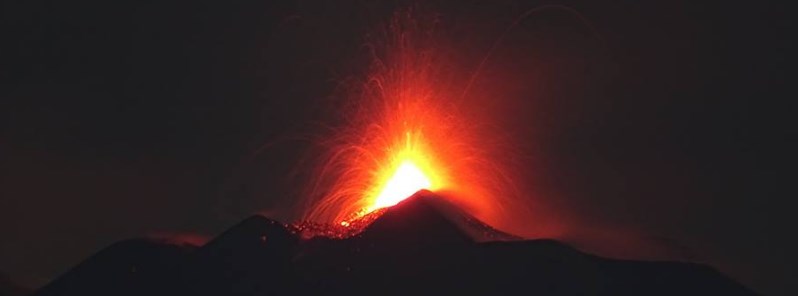New eruptive activity at Etna’s New Southeast Crater, Italy

New eruptive activity started at Etna's New Southeast Crater on August 23, 2018 and continued into August 24.
The eruption began after seismic network detected a sharp increase in seismicity under the volcano at around 18:30 UTC (20:30 local time). The tremor was accompanied by mild strombolian activity from the new cone between the Northeast Crater (NEC) and New Southeast Crater (NSEC).
Short lava flows were observed a couple of hours later along the southeast flank in the summit area.
This month's activity at Etna was characterized by gas and ash emissions and Strombolian activity. Strombolian activity continued from vents in Bocca Nuova and was particularly visible at night.
Activity at NEC consisted of frequent ash emissions and Strombolian explosions. Explosions at the E crater on the E flank of the NSEC generated gray-brown ash plumes that sometimes rose several hundred meters above Etna’s summit and quickly dissipated.
Live streaming is available at the following link.
Geological summary
Mount Etna, towering above Catania, Sicily's second largest city, has one of the world's longest documented records of historical volcanism, dating back to 1500 BCE. Historical lava flows of basaltic composition cover much of the surface of this massive volcano, whose edifice is the highest and most voluminous in Italy.
The Mongibello stratovolcano, truncated by several small calderas, was constructed during the late Pleistocene and Holocene over an older shield volcano. The most prominent morphological feature of Etna is the Valle del Bove, a 5 x 10 km (16 404 x 32 808 feet) horseshoe-shaped caldera open to the east.
Two styles of eruptive activity typically occur at Etna. Persistent explosive eruptions, sometimes with minor lava emissions, take place from one or more of the three prominent summit craters, the Central Crater, NE Crater, and SE Crater (the latter formed in 1978). Flank vents, typically with higher effusion rates, are less frequently active and originate from fissures that open progressively downward from near the summit (usually accompanied by strombolian eruptions at the upper end).
Cinder cones are commonly constructed over the vents of lower-flank lava flows. Lava flows extend to the foot of the volcano on all sides and have reached the sea over a broad area on the SE flank. (GVP)
Featured image credit: Boris Behncke

Commenting rules and guidelines
We value the thoughts and opinions of our readers and welcome healthy discussions on our website. In order to maintain a respectful and positive community, we ask that all commenters follow these rules:
We reserve the right to remove any comments that violate these rules. By commenting on our website, you agree to abide by these guidelines. Thank you for helping to create a positive and welcoming environment for all.